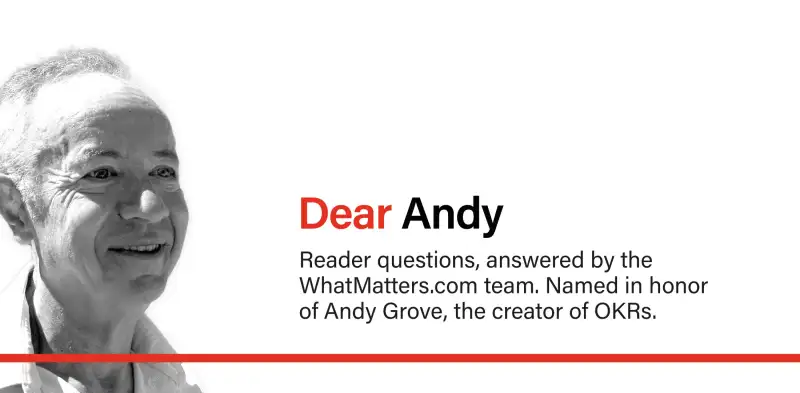Dear Andy,
My team knows how to write good OKRs, but do you have any advice on the OKR writing meeting itself? How should it be structured? Our last one felt a little chaotic: disorganized, went way too long, and things got a little heated. Any advice on how to streamline this process and keep everyone happy?
Sincerely,
Ari

Hi Ari!
Thanks for writing in with your excellent question.
Setting OKRs as a team thrives on spirited conversations and a lot of collaboration. Ideally, OKR discussions are a space where different priorities are considered, allowing fresh insights to emerge. Dialog is crucial in aligning teams towards common goals. As John Doerr likes to say: For most opportunities, there’s more than one right answer.
Here’s how to lay the groundwork for success: have team members arrive at the kickoff meeting with draft Objectives and potential Key Results in hand. Having them generate before getting together reduces groupthink. Also, not everyone feels comfortable sharing their ideas out loud, so many companies (like the team from Emancipet) create a shared digital document (like a Google Doc) for draft OKRs.
For the kickoff meeting, each team member shares their prepared Objectives. Spend a healthy amount of time identifying commonalities and differences among the proposals before agreeing what does the most good for the company. Comparing diverse perspectives helps create a common understanding of success.
Group similar Objectives together. As important themes emerge from each cluster, synthesize them into a clear, coherent Objective. If the Objective is vague, ask for a sample Key Result and see if it helps clarify the Objective.
Now, distill the priorities down to two to three. Disagreements are natural at this step because it involves working through contradictions and trade-offs. Resolve these issues one by one. And if conversations devolve into ‘horse-trading’ for resources and approvals, keep asking, “What would accomplish the most good for the organization right now?”
With clear Objectives in place, it’s time to define (or refine) Key Results. These should be specific, time-bound, ambitious yet realistic, and verifiable. You may need to repeat the steps above until everyone in the room has agreed on the OKRs.
You now have a single page of agreed-upon priorities. This is the moment to assess if the OKRs are suitably ambitious and aligned with the organization’s broader goals. And there you have it – OKRs!
Perfecting those team-level OKRs is a bit of a jigsaw puzzle. Deep thought and open dialogue help you stay true to the organization’s North Star. Stick to these steps, and your next OKR writing session will go much more smoothly!
Thanks for writing in, Ari, and best of luck to you and your team on your OKR journey.
Sincerely,
Billy from the What Matters Team

